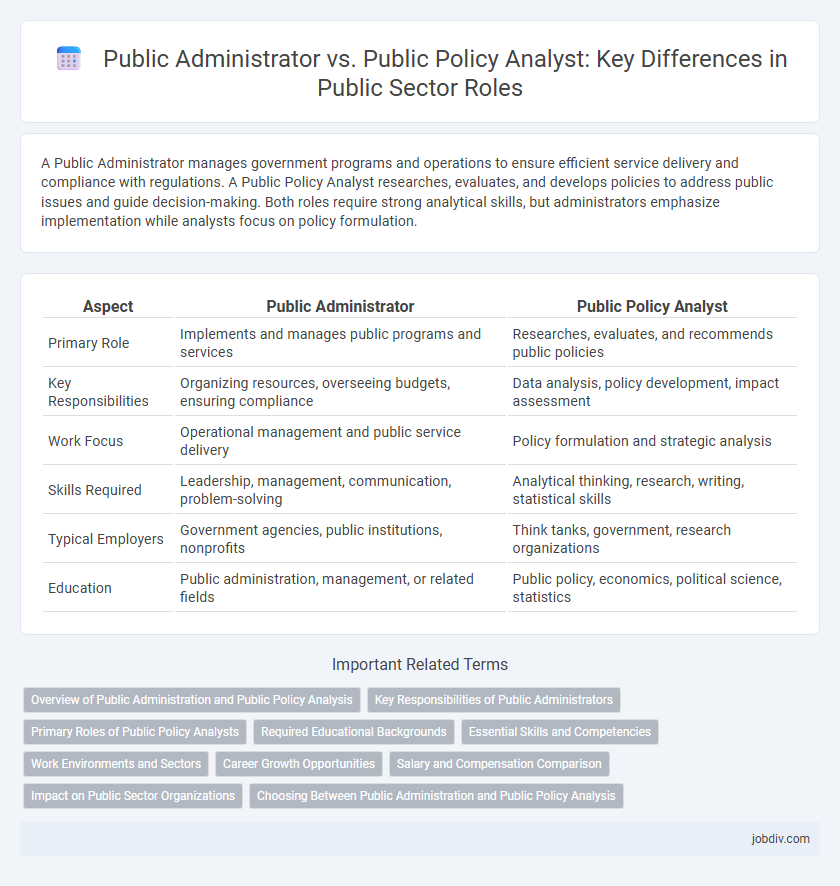A Public Administrator manages government programs and operations to ensure efficient service delivery and compliance with regulations. A Public Policy Analyst researches, evaluates, and develops policies to address public issues and guide decision-making. Both roles require strong analytical skills, but administrators emphasize implementation while analysts focus on policy formulation.
Table of Comparison
| Aspect | Public Administrator | Public Policy Analyst |
|---|---|---|
| Primary Role | Implements and manages public programs and services | Researches, evaluates, and recommends public policies |
| Key Responsibilities | Organizing resources, overseeing budgets, ensuring compliance | Data analysis, policy development, impact assessment |
| Work Focus | Operational management and public service delivery | Policy formulation and strategic analysis |
| Skills Required | Leadership, management, communication, problem-solving | Analytical thinking, research, writing, statistical skills |
| Typical Employers | Government agencies, public institutions, nonprofits | Think tanks, government, research organizations |
| Education | Public administration, management, or related fields | Public policy, economics, political science, statistics |
Overview of Public Administration and Public Policy Analysis
Public Administration involves the implementation of government policies and the management of public programs, emphasizing organizational structure, budgeting, and public service delivery. Public Policy Analysis focuses on evaluating and developing policy options through research, data analysis, and impact assessment to inform decision-making processes. Both fields intersect in promoting effective governance, with public administrators managing policy execution while analysts provide evidence-based recommendations.
Key Responsibilities of Public Administrators
Public administrators manage government operations, oversee budgeting and resource allocation, and implement public programs to ensure efficient service delivery. They coordinate interdepartmental communication and enforce compliance with laws and regulations. Their key responsibilities include strategic planning, staff supervision, and evaluating program effectiveness to meet community needs.
Primary Roles of Public Policy Analysts
Public Policy Analysts primarily conduct research, analyze data, and evaluate the effectiveness of government programs to guide evidence-based decision-making. They synthesize complex information to develop policy recommendations that address public issues and align with legislative goals. Their role involves stakeholder consultation and impact assessment to ensure policies achieve intended social and economic outcomes.
Required Educational Backgrounds
Public Administrators typically require a bachelor's degree in public administration, political science, or business administration, with many positions preferring a master's degree such as a Master of Public Administration (MPA). Public Policy Analysts often hold advanced degrees in public policy, economics, or political science, emphasizing strong analytical and research skills gained through master's or doctoral programs. Both careers benefit from specialized coursework, internships, and practical experience related to government operations and policy formulation.
Essential Skills and Competencies
Public Administrators excel in leadership, organizational management, and strategic planning, ensuring effective implementation of government programs and policies. Public Policy Analysts possess strong analytical, research, and data interpretation skills to evaluate policy impacts and provide evidence-based recommendations. Both roles require excellent communication, problem-solving abilities, and a deep understanding of governmental processes and public sector regulations.
Work Environments and Sectors
Public administrators typically work within government agencies at local, state, or federal levels, focusing on managing public programs and services in sectors such as healthcare, education, and urban development. Public policy analysts often operate in think tanks, research institutions, and advocacy organizations, analyzing data and crafting policy recommendations across diverse fields including environmental regulation, social welfare, and economic development. Both roles may intersect in nonprofit sectors, but public administrators emphasize operational leadership while policy analysts prioritize strategic evaluation and policy formulation.
Career Growth Opportunities
Public Administrators often advance into leadership roles such as city managers or department heads, leveraging their expertise in organizational management and public service delivery. Public Policy Analysts typically progress by specializing in data-driven policy evaluation and advising government agencies or think tanks, with potential growth into senior research or consultancy positions. Both careers offer pathways to influence public sector decision-making, but Administrators focus more on execution and management, while Analysts emphasize research and policy formulation.
Salary and Compensation Comparison
Public Administrators typically earn median salaries ranging from $65,000 to $85,000 annually, influenced by government level and experience, while Public Policy Analysts often command slightly higher pay, averaging between $70,000 and $90,000. Compensation packages for both roles may include benefits such as health insurance, retirement plans, and performance bonuses, with analysts sometimes receiving higher bonuses due to their roles in strategic planning. Geographic location and sector--federal, state, or local government--significantly impact salary variations within these public sector positions.
Impact on Public Sector Organizations
Public administrators manage the implementation of policies and oversee daily operations within government agencies, directly influencing public sector efficiency and resource allocation. Public policy analysts conduct research and evaluate policy options to inform decision-making, driving evidence-based improvements and strategic planning in public programs. Their combined efforts enhance organizational performance, accountability, and responsiveness to community needs.
Choosing Between Public Administration and Public Policy Analysis
Choosing between public administration and public policy analysis depends on career goals and skill sets. Public administrators focus on managing government operations and implementing policies, emphasizing organizational leadership and resource management. Public policy analysts concentrate on researching, evaluating, and developing policies, requiring strong analytical and research skills to influence decision-making.
Public Administrator vs Public Policy Analyst Infographic

 jobdiv.com
jobdiv.com